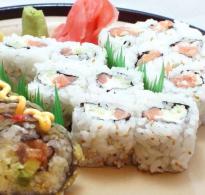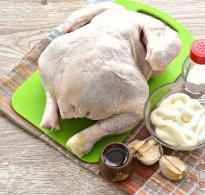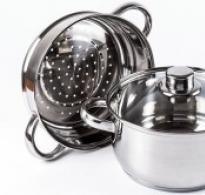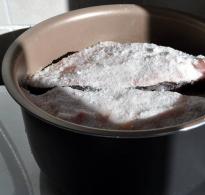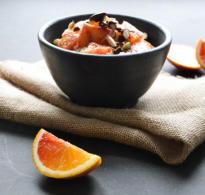Instant noodles harm and research benefits. Is there any harm from instant noodles
Instant pasta is, according to GOST 31749-2012, products made from wheat flour and water using additional raw materials and dried in oil. Instant noodles or vermicelli intended for sale should be packed in containers or glasses with a lid on top or plastic bags. According to GOST, instant pasta should not stick together after cooking. They should retain the shape of a corrugated string of noodles (vermicelli) after 15 minutes from the moment they are poured with boiling water.
Instant pasta is in demand among travelers, office workers, summer residents, workers. Add a variety of flavors to the convenience of packaging and ease of preparation - and you will get the secret of the popularity of instant noodles or noodles, in everyday life called "doshirak".
But this product also has a lot of opponents. They are confused by the abundance of "incomprehensible" components in the composition.
To dot the i's, Roskontrol experts examined the ingredients listed on the labels of 17 instant pasta brands such as Big Bon, Big Lunch, Doshirak, Red Price, Rollton.
Are there any hazardous to health in the declared ingredients?
Common in each sample are flour, oil and vegetables

All samples in the composition are declared Wheat flour and vegetable oil(soy or sunflower), as well as a variety of dried vegetables. As a rule, it is onions, tomatoes, paprika, garlic, celery, carrots, corn, parsley.
Meet mushrooms("Chan ramyon" ("Doshirak") noodles, noodles on homemade "Rollton" broth with mushrooms).
In "Doshirak" with kimchi flavor and in "Doshirak" with pork flavor added seaweed(kelp).
Do instant noodles contain meat?

Beef taste! Pork! Chicken bouillon! - the labels promise us. But is there real meat inside?
Of our 17 samples, 14 packages report the presence of meat or meat (including poultry) in large, catchy print.
In which of them the manufacturers did not regret adding real meat ingredients? This “Red Price”, “Rollton” and Big Bon.
The product “Vermicelli with beef broth“ Red Price ”contains cooked-dried minced beef.

Rollton noodles and noodles (meat and chicken) have dried beef / chicken attached to the pasta. Plus the matching flavors.
The Big Bon Beef + Tomato Sauce Ingredient List also lists dried beef.
And in Big Bon “chicken + salsa sauce” and “chicken noodles with spicy sauce” - dried chicken.

The "Chan Ramen" noodles distinguished themselves from "Doshirak" - there is not a word about meat on the front side of the package, but the composition printed in small print contains beef powder and beef flavoring.
The experts considered the most controversial products under the brand name "Doshirak".
Big on the label - "Pork Flavored Noodles". The list of ingredients includes pork broth powder.
The label reads “Hearty Beef Flavored Lunch”. Beef is represented by the protein product "soy meat", followed by beef extract, beef broth powder.
On the label: Chazhang Myung noodles with vegetables and pieces of meat. A as a part of meat - only lard... You can hardly call it meat!
Attention! The inscription on the label does not always correspond to the composition! If it says "taste of meat" - there may not be meat in the composition. And vice versa. So read the ingredients carefully before buying.
Supplements for whom?

- Preservatives
The preservative E 211 (sodium benzoate) was found in all three types of Big Bon pasta, as well as in noodles with beef in a spicy Big Lunch sauce and in the product Doshirak hearty lunch with beef flavor.
In the same samples, the preservative E202 (potassium sorbate) is declared in the composition.
In other types of noodles and vermicelli, preservatives are not declared among the ingredients.

Burnt sugar is used as a dye in noodles with beef broth "Red Price"
- Dyes
5 samples of beef noodles contain sugar color (E150d), or, more simply, burnt sugar. Tints products in “caramel” brown color. Weak carcinogen. Safe for health in small quantities.
- Stabilizers and thickeners
Guar and xanthan gums - in all samples, except for noodles in homemade Rollton broth (mushroom, chicken, beef, bacon). Gums are harmless to the body.

- Acidity regulators
Sodium acetate and diacetate, citric acid, lactic acid, succinic acid, acetic acid, calcium lactate ... such a “chemistry” that controls a given acidic environment is in different variations in “Big Lunch” and Big Bon.
In samples of other brands, acidity regulators are not indicated. In large quantities, acids cause irritation of the mucous membrane, can provoke the development of gastritis, ulcers, etc.
It is believed that the main harm of instant noodles is in food additives such as preservatives, flavor enhancers, artificial colors, etc. However, all the ingredients (from those indicated in the composition of our samples) are permitted by law, which means that we have no reason to claim that they are hazardous to health.
On the other hand, instant noodles made from premium wheat flour, poor in micronutrients, are not the best choice for people leading a healthy lifestyle.
The abundance of salt in foods such as instant noodles, when consumed regularly, is a risk factor for hypertension - high blood pressure.
Ingredients such as hot spices are a risk factor for digestive diseases.
For reference:
Hydrogenated fats are hardened liquid vegetable fats in which, during modification (hydrogenation), harmful trans fats are formed - a proven risk factor for the onset of diseases of the circulatory system (atherosclerosis).
IMPORTANT
Instant pasta can contain hydrogenated fat. It is in them that the real harm to the body lies.
I must say that none of the samples tested contained hydrogenated fat... However, in many types of similar products they are included in the composition.
Whose composition is more natural?
Instant noodles do not contain anything useful and necessary for our body. This is a very harmful fast food. Regular consumption of such food can lead to the development or exacerbation of gastrointestinal pathology, for example, gastritis, gastric ulcer and duodenal ulcer. An increase in acidity and pain in the epigastric region are the first signs of an incipient disease; during this period, you should stop using such noodles.
The development of such diseases is associated with the low quality of the finished product, with a high content of flavorings, antioxidants and stabilizers. This situation is aggravated by dangerous food addiction, when our brain requires these substances often and regularly. In addition, we are "captivated" by the speed and simplicity of preparation.
Many consumers report that the "seasonings" added to the noodles are extremely hot or salty. This leads to increased blood pressure, a tendency to edema and the development of kidney disease. Also, this product is quite high in calories. Because of monosodium glutamate (a flavor enhancer), sometimes 1 serving is not enough for us to get enough. As a result, we eat more than is required and this leads to weight gain and the development of obesity.
The life of a modern person is so hectic and dynamic that there is absolutely no time for good nutrition. Instant noodles in this case have become a real salvation. On the one hand, it turns out to have lunch or dinner in record time, and on the other, its cost can significantly save the family budget. Therefore, this product has become widespread both among business people and among students or families with low incomes. According to statistics, more than 80 billion servings are eaten worldwide every year.
How are instant noodles made?
The impetus for the invention of a commodity so much needed at the present time was the war between Japan and China. The fact is that the Chinese soldiers were given dried noodles, which they simply gnawed. And only later did people figure out how to brew it. Modern production of noodles has been brought to almost complete automation. For its preparation, flour with a high protein content is used. Then the dough goes through the roasting and evaporation procedure. Many people still don't know if instant noodles are bad for you. In fact, the resulting dough contains neither useful nor hazardous substances. However, manufacturers are constantly striving to change the product in order to increase their competitiveness in the market for similar products. To do this, they add various flavor enhancers and other additives that have an extremely negative effect not only on the figure, but also on health.
Instant noodles: harm

As everyone knows, monosodium glutamate is added to any semi-finished product. In its natural form, this substance undoubtedly has a positive effect on the body, improving well-being, raising mood and even improving male function. However, the element E 621 is added to the noodles, that is, artificially created glutamate. Its cost is much less than its natural counterpart, and the possibilities are much wider. Manufacturers with the help of glutamate can give absolutely any taste and smell to noodles. Moreover, when consumed frequently, instant noodles are addictive, and then fresh products seem tasteless. As a result, the body does not receive the necessary vitamins and useful microelements, metabolic processes are naturally disturbed, and an allergic reaction to many foods manifests itself. And at the last stage, obesity occurs.
Instant noodles: is the game worth the candle?

Of course, if you eat “from the package” once a month as needed, nothing bad will happen. But everyday use of this dish is highly undesirable. It is better to preserve your own health in advance than to go to doctors with a whole bunch of various diseases later. For example, in the evening you can prepare yourself a lunch made from natural products and take it with you to work. And with a slight feeling of hunger, it is better to give preference to fruits, for example, apples or even high-calorie bananas. The latter will help you get rid of hunger for a long time and maintain an excellent mood.
Ramen, a Japanese instant noodle soup, is considered a staple food for schoolchildren and students around the world. However, regular consumption of ramen noodles can seriously harm your health. Read on to learn about the nutritional value of ramen noodles and why eating them daily is bad for your health.
While Americans and Europeans celebrate their birthdays with cakes, the Chinese celebrate noodle parties. Instead of baking birthday cakes, they serve up holiday noodles! In Chinese culture, noodles are a symbol of longevity. Therefore, it is an integral part of the birthday menu, as well as the menu that is specially planned for the Chinese New Year.
Despite the fact that noodles are a budget instant product, they can keep you feeling full for a long time. Which country is the homeland of this dish, Japan or China, is not clear, but today it is popular in almost all corners of the world and can be called an "international food". Let's take a look at the cons of consuming these instant noodles regularly.
Why You Should Avoid Eating Daily Ramen Noodles
High in saturated fat
Although noodles generally symbolize longevity in Chinese culture, ramen noodles can be unhealthy as they belong to the processed food category. It is pre-fried and therefore takes less than five minutes to cook. However, due to the deep frying method, it has a high saturated fat content. The total fat in 100 grams of ramen noodles is 17.59 grams, with 50% of this fat being saturated fat. They can cause an increase in blood cholesterol levels, and ultimately lead to other health problems such as weight gain, high blood pressure, and the development of certain cardiovascular diseases.
Excess sodium
In addition to the pre-fried noodles, the ramen noodle package contains a small sachet of seasoning that, when added to the noodles, significantly increases the sodium content of the dish. There are 1,855 milligrams of sodium per 100 grams of noodles. That's more than half of her RDA for adults. People who have been diagnosed with high blood pressure and those who are at increased risk of this condition should reduce their sodium intake. For them, eating ramen noodles may carry a greater risk than for other people.
Monosodium glutamate and tertiary butylhydroquinone
Hazardous chemicals such as tertiary chemicals are added as preservatives to ramen noodles to extend shelf life. butylhydroquinone - a by-product of oil production... Moreover, monosodium glutamate is used to enhance the flavor of the noodles. Preservatives delay the appearance of rancidity, but cannot be absorbed in the body properly and in certain ways affect the functioning of its various systems. Excessive intake of MSG can cause headaches, weakness, nausea, chest pain, palpitations, tingling sensations in the face, hands and feet, etc. While further research is needed to prove these substances are harmful to health, it is best to avoid foods containing them.
Although made from wheat flour, ramen noodles are low in nutrients. It contains some vitamins and minerals, but other healthier foods are packed full of nutrients. For example, fruit and vegetable smoothies, salads, yoghurts with berries, baked or grilled fish / chicken, etc. Although ramen noodles are inexpensive, they are not a good option, given the cost of poor health later on.
Nutritional value,serving size: 100 g
Compound | Water Calories Squirrels Total fat Carbohydrates Dietary fiber Total sugars | 6.52 g 440 kcal 10.17 g 17.59 g 60.26 g 2.9 g 1.98 g |
| Minerals | Calcium Iron Magnesium Phosphorus Potassium Sodium Zinc | 21 mg 4.11 mg 25 mg 115 mg 181 mg 1855 mg 0.60 mg |
| Vitamins | Vitamin C Thiamine Riboflavin Niacin Vitamin B6 Folate Vitamin B12 Vitamin A, RAE Vitamin A, IU Vitamin E (alpha-tocopherol) Vitamin K (phylloquinone) | 0.3 mg 0.448 mg 0.255 mg 5.401 mg 0.038 mg 165 mcg 0.25 mg 1 μg 12 IU 2.44 mg 8.9 mcg |
| Fats | Total Saturated Fatty Acids Total monounsaturated fatty acids Total polyunsaturated fatty acids Fatty acids, total trans fat | 8.117 g 6.156 g 2.198 g 0.065 g |
Useful alternatives
One package of ramen noodles (85 grams) actually contains two servings, but people usually consume all of its contents in one go. If you can't completely skip ramen noodles right away, you can eat half a packet at a time. Also, you don't need to use the small sachet of seasonings. This helps to reduce the sodium content of the noodles. It's better to just add a pinch of salt and pepper.... You can also add eggs, spinach, lean meats, or other vegetables. This increases the nutritional value of the dish. Along with the noodles, you can have a healthy salad, bread, or fruit. 100 grams of reduced fat and sodium ramen noodles have 1200 mg of sodium, and the total fat (non-saturated and non-trans fat) is 2.50 grams. And if you completely avoid eating ramen noodles, it is acceptable to include such an option in the diet.
Recently, a gastroenterologist posted a video on the Internet demonstrating how our stomachs actually process preservative-containing ramen noodles and homemade noodles. He used a miniature camera to film the process. The results are clear and surprising. They indicate that homemade food is easily digested, while processed food is very difficult for our body to process. So, now it's easy to imagine how serious regular consumption of processed food can harm our body.
Video
Instant vermicelli appeared on the shelves of domestic stores relatively recently (about 10 years ago) and became widespread in a very short period of time. Its main advantages include speed of preparation, excellent taste and low cost of the product. Therefore, it becomes quite obvious the feasibility of producing such products, because the demand for them is characterized by stability.
Technological process for obtaining instant noodles
At first glance, all types of noodles differ from each other only in packaging. At the same time, the manufacturing technology of the product can be different, this concerns the frying stage. For these purposes, palm (more expensive) or vegetable oils are used. In the first case, the shelf life is one year, and in the second, only 3 months.
The main feature of the technology for the production of instant pasta is the complete automation of the production process. The line with a high productivity of 5-8 thousand packages per hour can be serviced by no more than seven people. At the same time, there are no special requirements for the level of qualifications of employees.

The technology for the production of instant pasta consists of the following stages:
- kneading dough;
- the formation of thin pasta;
- heat treatment with steam;
- drying;
- frying;
- packaging
It is better to use wheat flour with a high protein content as a raw material. It is carefully sieved, a certain amount of water is added and a thick dough is kneaded.

The finished dough is sent under a press, where it is rolled out and pressed (until it becomes like Egyptian parchment).


The dough sheets fall under the knife, which in its appearance resembles an ordinary rolling pin.

He cuts the layer into hundreds of thin threads. The wavy shape is ensured by two moving conveyors located on either side of the knife.

One of them moves a little faster than the other. Due to the difference in speed, the noodles fall into the cork and deform slightly.



Steaming and frying in a deep-frying system ensures almost complete readiness and quick cooking of the product. Using palm oil will give the vermicelli a golden hue and extend the shelf life.
The vending machine then packs the finished product by adding packets of seasoning, vegetables and oil.

Manufacturers often use a film that is thermally sealed with two seams. Metallized packaging will not let in sunlight and will create the most favorable conditions for increasing the shelf life of the finished product.
The pasta then passes through another conveyor in which each pack is weighed. If the control system detects underweight or overweight, then the package must be removed from the batch.

Vermicelli is also examined by a metal detector for various parts (screws, screws, etc.)
Spices are packaged using a modular filling machine.

It is advisable to purchase them ready-made. The main secret of quick noodles is their readiness - they are already cooked and fried. The consumer can only pour boiling water over it.
The relevance of the production of instant noodles (BP)
Today in Russia about 20 factories produce instant noodles. The most famous are “ Rollton" and " Doshirak". Regular entry of new entrants to the market testifies to the growing demand for such products. According to the research carried out, the greatest demand is for instant noodles with bacon, chicken and mushroom flavors. Often, consumers purchase such products on their way home (work), in markets or in nearby stores. Even in supermarkets, instant pasta is placed on separate shelves.

A favorable factor that contributes to the organization of production is the lack of specific ingredients. All raw materials and components are characterized by availability and have a stable price. This will allow maintaining a stable production cost, which is approximately 10-15 rubles (60-gram package).
At present, the Russian market for instant noodles is not yet at the saturation stage. The long-term plans of large enterprises include the expansion of production and the production of such vermicelli.
The market for instant food has great potential, since in conditions of a shortage of free time, a modern person prefers these particular products.
Guys, we put our soul into the site. Thank you for
that you discover this beauty. Thanks for the inspiration and the goosebumps.
Join us at Facebook and In contact with
Instant noodles were invented in medieval China, during the Qing dynasty. Chef Yi Bingshou tried to fry the noodles in oil so that he could quickly boil them before the guests arrived. After several centuries in Japan, this recipe gained popularity again, and today such noodles have become one of the most talked about "quick" foods in the world. Even medical scientists are worried about how harmful it is.
From 1948 to 1971, Japanese Momofuku Ando worked to make the noodles cheap, tasty, and convenient for consumers. After 20 years, he succeeded.
We are in site decided to analyze in detail the composition of instant noodles and additives offered by its manufacturers. We will tell you how harmful the product turned out to be.
The composition of the instant noodles themselves
The composition of the noodles themselves is absolutely ordinary. Not useful, very "empty" and at the same time high in calories. And all the chemistry is concentrated in the broth additive.
Instant noodle production
The key technology is frying noodles in oil. It is thanks to the heat treatment that the noodles soak in boiling water in a minute.
Most manufacturers choose palm oil for frying - it is the cheapest vegetable oil. The most common concern concerns precisely palm oil: when heat-treated, it breaks down into trans fats, that is, it becomes literally toxic to the body.
An incredible number of conflicting judgments go around him: someone is afraid like fire, and someone proves his harmlessness. Scientists do not have a single point of view today.
Flavoring additives for noodles: composition, benefits and harms
In addition to chemicals, the broth additive always contains a lot of spices, hot peppers and salt. Therefore, it immediately falls under a strict ban for people with any gastric ailments.
We have collected those chemical additives that are found in almost every manufacturer of instant noodles. We will tell you how they affect the body.
Monosodium glutamate E-621 - flavor enhancer
Monosodium glutamate has no flavor of its own, but enhances the flavor of the product to which it is added. The human tongue has special receptors responsible for taste called "umami" - the taste of high-protein substances. When the tongue feels it, the body perceives the taste of food more intensely, because it hears the signal: "This food is high in protein." So monosodium glutamate gives the sensation of the minds.
Monosodium glutamate itself is not an unnatural substance; it is even present in some foods naturally. In soy sauce and Roquefort cheese, for example. And for the human body, it is harmless if consumed in reasonable quantities.
Guar gum E-412 - thickener
This is an extract of Indian acacia pods - guar beans. Increases the viscosity of the product, forms a structured gel. Guar gum is often found in yoghurts, sauces, and ice creams.
It is believed that in small quantities it reduces appetite and is absorbed by the intestines in scanty amounts, that is, it cannot be too harmful.
In the twentieth century, nutritionists experimented with gum-based weight loss aids, but after several deaths from overdose, they stopped this business. Manufacturers now handle guar gum very carefully.
Sugar color E-150d - dye
E-150d dye is the most dangerous type of E-150 dye. The sugar color itself is, roughly speaking, burnt sugar. It is safe in small amounts, but it must be treated with caution. It is believed that this is a weak carcinogen that provokes the development of cancer cells in the body. The point of view is controversial, but popular.
Acidity regulators
Additives to noodles: dried vegetables and meat
The little dry pieces in the second bag are just very hard dried vegetables. And what is positioned as meat is soy, soy meat. A study conducted by Rospotrebnadzor showed that real meat is almost never added to the product.

